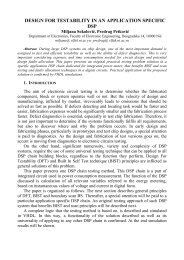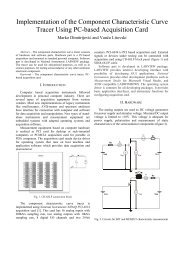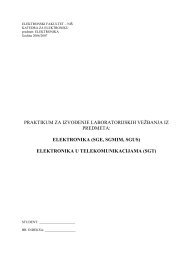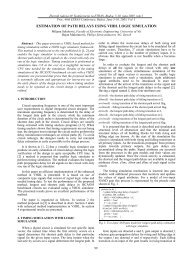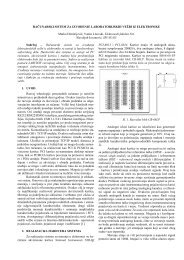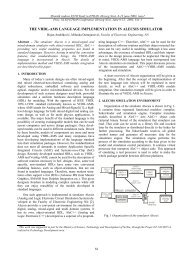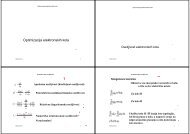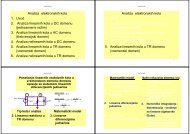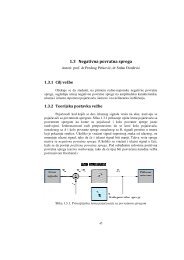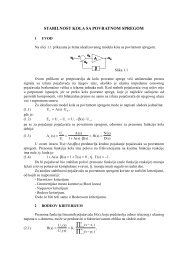6. Digital simulation in Alecsis - LEDA
6. Digital simulation in Alecsis - LEDA
6. Digital simulation in Alecsis - LEDA
You also want an ePaper? Increase the reach of your titles
YUMPU automatically turns print PDFs into web optimized ePapers that Google loves.
<strong>6.</strong> <strong>Digital</strong> <strong>simulation</strong> <strong>in</strong> <strong>Alecsis</strong> 99The ma<strong>in</strong> process is synchronized to be sensitive to all formal signals to the right of signal y. Symbol'$2' means the 'second formal signal by order.' The same signal appears <strong>in</strong> the code of the process, as well. Inthe process code it is legal to place an expression to the right of '$'. The result of the operation$expression is a formal signal at that position, with the type and direction from the declaration <strong>in</strong> the head<strong>in</strong>g.module andx (three_t out y; three_t <strong>in</strong> ...) action (double delay);module X () {andx and1, and2, and3;signal three_t s1, s2, s3, s4, s5, s6;}and1 (s3, s1, s2) delay = 10ns;and2 (s4, s1, s2, s3) delay = 12ns;and3 (s6, s1, s2, s3, s4, s5) delay=9.7ns;Operator '$' has the same priority as all other unary operators, which mean that parentheses must be usedwhen deal<strong>in</strong>g with a complex expression.$i + 1 // signal from position, added with 1 -- an error?$(i + 1) // signal from position i+1<strong>6.</strong><strong>6.</strong> Variable number of action parametersThe number of parameters <strong>in</strong> the header of the action block of the module can be variable, too. This isdescribed <strong>in</strong> the Chapter 5, as it is the same for digital and analogue modules.<strong>6.</strong>7. Array of components -- commands clone and allocateIn <strong>Alecsis</strong>, one can generate an array of previously declared components. Commands clone andallocate is used for that. Details of command clone are given <strong>in</strong> the chapter on analogue <strong>simulation</strong>, and arevalid for digital <strong>simulation</strong>, too.<strong>6.</strong>8. Structural aspect of digital circuitsThe f<strong>in</strong>al discussion <strong>in</strong> this chapter concerns the structural approach to digital <strong>simulation</strong>. This was the onlyway with older digital simulators, s<strong>in</strong>ce all digital components along with tables and system of states were built-<strong>in</strong>and fixed. <strong>Alecsis</strong> does not have any built-<strong>in</strong> digital component, but it does have mechanisms for creation ofextensive libraries of components. Such components can be used as they are built-<strong>in</strong>.<strong>Digital</strong> elements use the same syntax, parameter sett<strong>in</strong>g, declarations, etc., as analogue or hybridcomponents. AleC++ does not have a construct that would allow the compiler to guess if a component of somemodule type is analogue, digital, or hybrid.



